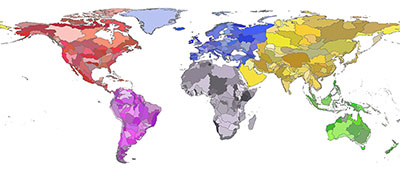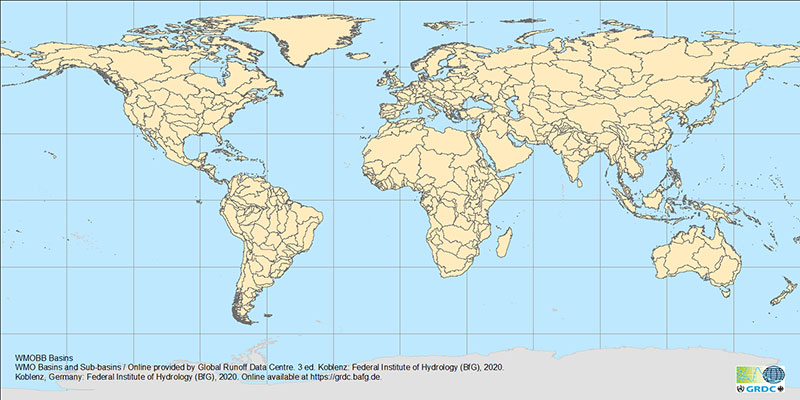WMO Basins and Sub-Basins (WMOBB) is an ongoing GIS project of the Global Runoff Data Centre (GRDC). It is provided for public use under the condition of full citation and reference to incorporated data from the HydroSHEDS database. This is the 3rd, revised and extended edition 2020 and replaces the catchment polygons of the edition 2017.

The meteorological and related activities of the WMO are coordinated by six Regional Associations (RAs), composed of WMO-Members from the respective region of the world. The current status of the RAs is published in WMO Publication No. 5: Composition of WMO (WMO 2020). For each WMO Region a “List of basin indicators (BB) and indicators of countries (C) used in international hydrological codes” is published in the “WMO Manual on Codes” (2011 ed., WMO 2018) for basin identification in international data sharing contexts. Within each WMO Region at maximum 99 WMO Basins are defined, representing a specific hydrographic region. Designated from a hydrographic perspective, a WMO Basin represents a river/lake basin in total or sub-basins of them. Coastal sections between the sea-outlets of rivers become separate WMO Basins, entire islands as are.
Hydrologically, WMO Basins are both river/lake basins with exorheic drainage, wherein all waters flow to a common outlet, ultimately into an ocean, but also basins with endorheic drainage, where all waters are collected in sinks or lakes not connected to other basins. From a geo-political perspective WMO Basins are mainly transboundary basins or country-specific basin-shares, or coastal sections between rivers which form country borders whereby island states are usually considered as a separate region.
GRDC uses the 2-digit basin codes (BB) for the principal identification of hydrological stations. For further orientation, the associated 1-digit country codes (C) are used, but not applied as strictly as the hydrographically determined basin codes. In 2004, GRDC generated the first graphical representation of the WMO Basins, the WMO Subregions dataset. Based on the flow direction dataset of HYDRO1k (USGS 2000), 486 sub-region polygons were delineated. The subregion names were updated in 2017, but the basin polygons remained unchanged.
With the HydroSHEDS (Hydrological data and maps based on SHuttle Elevation Derivatives at multiple Scales) mapping product a “suite of geo-referenced data sets in raster and vector format, including stream networks, watershed boundaries, drainage directions, and ancillary data layers such as flow accumulations, distances, and river topology information” (Lehner 2013) became available in a consistent format. HydroBASINS dataset provides a series of polygon layers of watershed boundaries and nested basin delineations following the Pfaffstetter coding principles. The HydroRIVERS dataset provides a global coverage of river reaches at high spatial resolution, each with a reference to the corresponding hydro-basin identifier. The HydroSHEDS database and more information are available at http://www.hydrosheds.org.
Seamless global coverage and 12 levels of sub-basin breakdown of HydroSHEDS offer the unique opportunity to base GRDC’s geospatial data products like the WMO Basin and Subbasins datasets on a comprehensive and widely accepted data product. The HydroBASINS (WWF 2013) subset of polygon layers is used for a review of basin boundaries, and the HydroRIVERS subset (WWF 2019) of polylines to derive river networks associated to the basin polygons.
WMO Basins
The WMO Basins dataset is extracted from the HydroBASINS dataset using basic selection and generalization procedures. It is important to note, that GRDC has not re-assembled the river or lake basins or delineated new watershed boundaries.

The region polygons of edition 2004 were reviewed against the hybas-polygons of the HydroSHEDS dataset (online received in March 2018), whereby some in version 2004 technically combined subregions were split.
The WMO Basins polygons are generated from dissolving all hybas-polygons at the highest spatial resolution level (hybas_lev12) that intersect a basin polygon of the extended edition 2004, always inspecting the basin polygons at the next (coarser) generalization levels. In this way, basin polygons are generated to build up the new dataset of 515 WMO Basins.
WMO basins and sub-basins are attributed with:
| WMOBB | identifier of hydrographic region |
| WMOBB_NAME | name of hydrographic region |
| WMOBB_BASIN | name of river/lake basin, coastal region or island forming a separate basin in terms of WMO Manual on Codes |
| WMOBB_SUBBASIN | name of river/lake basin forming a separate sub-basin in terms of WMO Manual on Codes |
| WMOBB_DESCRIPTION | description of hydrographic region |
| REGNUM | number of the WMO Region (Regional Association) |
| REGNAME | name of the WMO Region (Regional Association) |
| WMO306_MoC_NUM | reference to Manual on Codes, 2-digit basin code |
| WMO306_MoC_REFERENCE | reference to Manual on Codes, name of basin/sub-basin |
| SUMSUBAREA | approximate of drainage area (in square km), calculated by adding up the sub-area values specified in the hybas_lev12 datasets. The calculated drainage area does not reflect the real size of the region. |
WMO River Networks
The WMO River Networks dataset is extracted from HydroSHEDS dataset using basic selection and generalization procedures. It is important to note, that GRDC has not re-assembled the river networks using a flow accumulation grid.

The WMO River Networks are generated from dissolving river-reaches of the HydroRIVERS dataset (online received in February 2020) that intersect the WMO Basin polygons. To allow for displaying a scalable network of streams for both the smallest river basin and a huge basin, a subset of hydrorivers_v10 reaches where the “upland area” exceeds the median of all upland area values of 33.59 km² is selected and split by deciles into ten subsets of hydro-river reaches. Layers of line sections are generated for each decile interval. At the highest level (above the 0.9 quantile) river networks for 455 (of 515) basins are displayed. In this way, river networks may be assigned to the 515 WMO Basins and further densified by activating river network slices. River networks are attributed with properties of the associated basin.
References:
Lehner, B., Grill G. (2013): Global river hydrography and network routing: baseline data and new approaches to study the world’s large river systems. Hydrological Processes, 27(15): 2171–2186.
Lehner, B. (2013): HydroSHEDS technical documentation, version 1.2. World Wildlife Fund US, 1–25.
US Geological Survey (2000): HYDRO1k Elevation Derivative Database. USGS EROS Data Center, Sioux Falls, SD.
WWF (2013): HydroBasins, World Wildlife Fund. Data online available at www.hydrosheds.org. Online received in March 2018.
WWF (2019): HydroRivers, World Wildlife Fund. Data online available at www.hydrosheds.org. Online received in February 2020.
WMO (2018): Manual on Codes. Vol. II: Regional Codes and National Coding Practices. 2011 ed. updated 2018. (WMO; 306). World Meteorological Organization, WMO. Online available at library.wmo.int. Online received in February 2020.
WMO (2020): Composition of the WMO. (WMO; 5). World Meteorological Organization, WMO. Online available at community.wmo.int. Online received in February 2020.
Acknowledgements:
This product “WMO Basins and Sub-Basins” incorporates data from the HydroSHEDS database which is © World Wildlife Fund, Inc. (2006-2013) and has been used herein under license. WWF has not evaluated the data as altered and incorporated within “WMO Basins and Sub-Basins”, and therefore gives no warranty regarding its accuracy, completeness, currency or suitability for any particular purpose. Portions of the HydroSHEDS database incorporate data which are the intellectual property rights of © USGS (2006-2008), NASA (2000-2005), ESRI (1992-1998), CIAT (2004-2006), UNEP-WCMC (1993), WWF (2004), Commonwealth of Australia (2007), and Her Royal Majesty and the British Crown and are used under license. The HydroSHEDS database and more information are available at http://www.hydrosheds.org.
Recommended citation:
GRDC (2020): WMO Basins and Sub-Basins / Global Runoff Data Centre, GRDC. 3rd, rev. ext. ed. Koblenz, Germany: Federal Institute of Hydrology (BfG).
| Download |
|---|
| GeoJSON (ZIP, 361MB) |
| ESRI Layer Package (ZIP, 118MB) |
| ESRI Shapefiles (ZIP, 166MB) |
| Tabular Summary (ZIP, 895KB) |
| Technical Documentation (PDF, 303KB) |